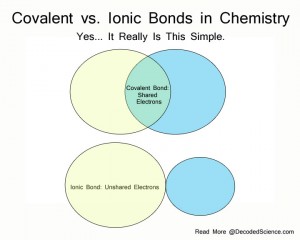Almost all atoms found in nature, left alone, are stable structures. If they always stayed that way, chemists wouldn’t need it.
Fortunately, atoms can react in many ways in close contact.
They often join together in various combinations through binding to form molecules called compounds.
This interaction requires clarification and therefore provides employment for people educated in this field: the field called chemistry.
Chemical bonds: ionic and covalent
Atoms combine in many ways. Some bonds are weaker and some stronger. The two strongest forms of chemical bond are ionic and covalent bonds. Chemical bonds form between two atoms, each with its own electronic environment.
If each of the two atoms almost shares an electron with the other, the bond is called covalent.
If one atom exerts a significant force on the electron of the other atom, while the other atom tries to give away its electron, the bond is largely ionic.
Which form of bond – covalent or ionic – is stronger? The easiest way to determine this is to measure the energy needed to break the bond. This amount is called bond dissociation energy. The greater the energy needed to break a bond, the stronger this bond must be. It turns out that most ionic bonds are much more difficult to break than covalent bonds.
Ion bonds: electronegativity
In the 1930s, Dr. Linus Pauling explained the quality he called electronegativity. Some atoms, if they can be humanized, want to increase the electron density. Others want the exact opposite. He compiled a list of numbers describing this affinity. The presence of significant electronegativity promotes the formation of ionic bonds.
The easiest way to determine which of the ionic bonds are the strongest is to study the electronegativity of the anion (negative part of the compound) and its cation (positive part of the compound).
Linus Pauling has compiled a list of numbers that quantify the property of electronegativity. Image courtesy of the US Library of Congress
Alkali metals and halogens
Alkali metals are the least electronegative elements found in the periodic table, while halogens are the most electronegative elements. We give three combinations of these elements: lithium iodide, potassium chloride and rubidium fluoride.
- LITHIUM IODIDE ———- 352 KILOJOULES FOR MOLE
- POTASSIUM CHLORIDE – 427 KILOJOULES PER MOL
- RUBIDIUM FLUORIDE —– 494 KILOJOULES PER MOL
Ionic bonds in complex franc fluoride should be stronger than even these. This is the most electropositive of the elements. It follows that calcium is also the least electronegative element.
Chemical bonds and electronegativity
In chemistry, we study the interactions between atoms. The elements connect to each other using chemical bonds; covalent and ionic, including electronegative elements of Linus Pauling. Which bonds are the strongest? It depends on their properties.
Resources
University of Buenos Aires. Properties of Atoms, Radicals, and Bonds. Accessed October 15, 2013.
Linus Pauling. The Nature of the Chemical Bond. Electronegativity: Narrative. Oregon State University. Accessed October 15, 2013.

































